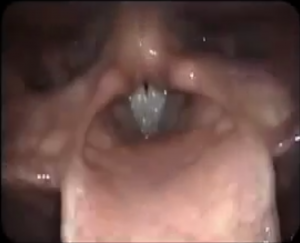Have you ever heard someone sing with a breathiness to their tone? Sometimes singers use breathiness as a way to style a particular phrase or note, but if the singer has a constant breathiness, chances are they have not mastered the art of cord connection. Not having this skill can be a detriment to your performance. Mastering this skill is a game changer.
Cord Connection
What is cord connection? Simply put, it is the action of connecting your vocal cords from the front to the back. When we breathe, the vocal cords open wide to allow air to pass through to the lungs. To talk or to sing, the vocal cords close and vibrate against one another as we exhale. The main muscle that engages to perform this process is called the arytenoid muscle. It is solely responsible for the production of sound.
When we speak, we produce short bursts of air and sound with little change in pitch. The majority of people are born with this ability. Unless you are a professional speaker, cord connection is not a big deal. However, a singer must maintain these sounds for long periods of time so cord connection is a must.

Vocal cords with poor cord connection.
The Danger
Think of a car tire with a small hole in it. At first, the tire may perform well as air slowly leaks from it. But after a while, the tire loses so much air that it affects the performance of the entire vehicle. The same things happens to the voice. The voice’s only fuel source is air. If there is a leak in the vocal chords, the singer loses precious power. The result can be taking catch breaths which destroys the motion of the song or even worse, the mind goes into emergency mode and engages muscles in the throat to counteract the loss of air. Doing so can harm and weaken the voice.
How Can I Train?
As said before, the arytenoid muscle is in charge of cord connection. The best exercise for strengthening the arytenoid muscle is the vocal fry. The vocal fry is bringing the cords together, bubbling air through them and maintaining this bubbling while increasing pitch. It sounds complicated but easy to accomplish.
First, we need to feel the arytenoid muscle. The feeling is very subtle so muscle memory is key. Exhale some hot air out, as if you were trying to fog up a mirror. After two seconds of this, sing a pitch on an “Ah” vowel without stopping the warm air. Again, don’t disconnect the breath before you sing. Just go right into the “Ah” from the warm air. Feel the arytenoid? Don’t worry if you don’t feel it the first time. Keep trying and eventually you will feel it.
Next, stop singing and freeze everything. Freeze the jaw, back of the the throat and most importantly, the vocal cords. So you will exhale hot air, sing “ah” without stopping the breath and freeze the muscle. Don’t relax anything in the vocal mechanism. The cords should be completely connected at this point. Now, blow air through your closed cords. The air should be bubbling through the cords with very little pressure. This is a vocal fry. But we’re not done.
In order to give the arytenoid muscle a workout, the cords must stay closed as we rise in pitch. To start, do what I call a break slide. Vocal fry the cords and do a small slide up in pitch. This is a good beginning workout. If the vocal fry continues throughout the slide, that means the cords are staying connected. After accomplishing this, take the slide even higher in pitch. If you can maintain cord connection throughout, try vocal frying some of your favorite exercises. Just remember, if the bubbling stops, the cords have disconnected. Go back and try it again.
The Result
If you are a professional singer, vocal frying will give you an almost immediate change in power and control. If you are a beginner, you will find that your voice responds quicker to training after using these exercises. Don’t give up. Teaching your cords how to vocal fry can be difficult but the rewards are huge. Good Luck!!!!
©2018 SeanyMac Studios, Sean Oliver All rights reserved.
